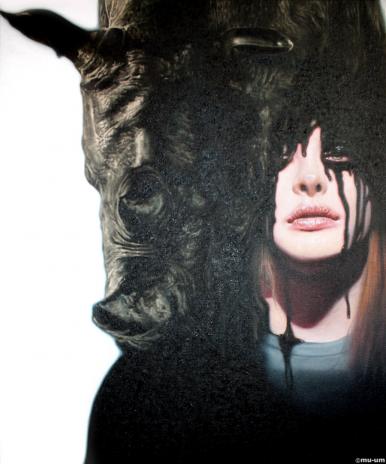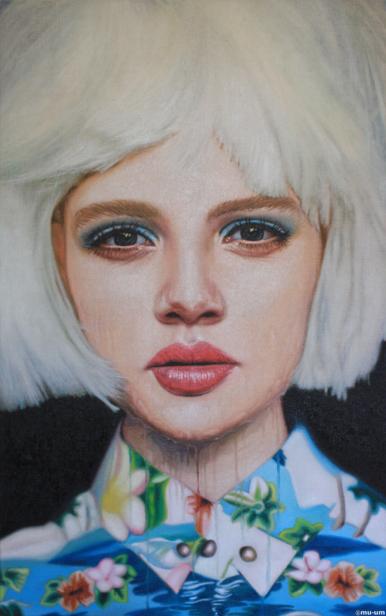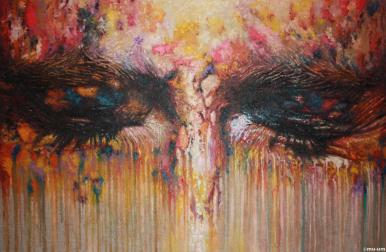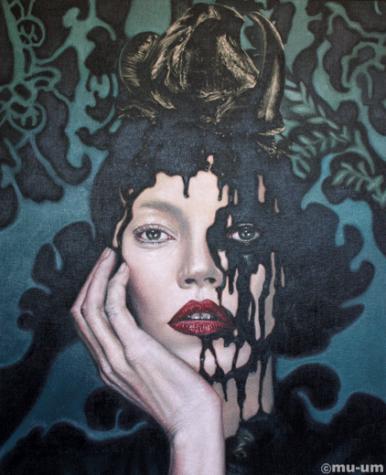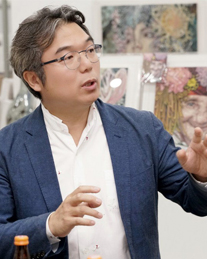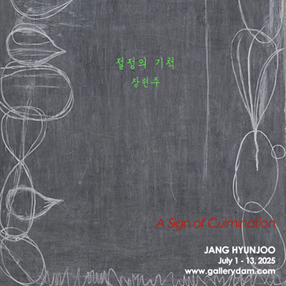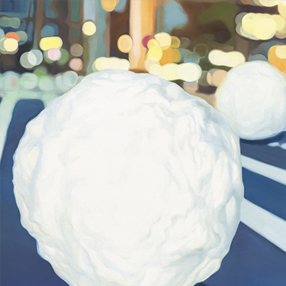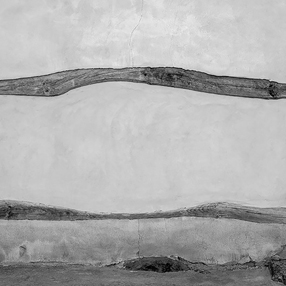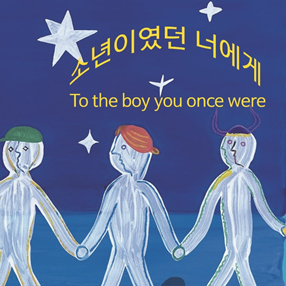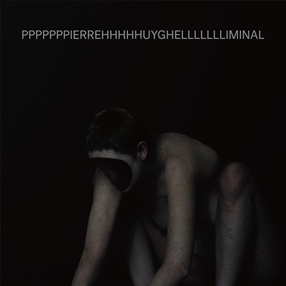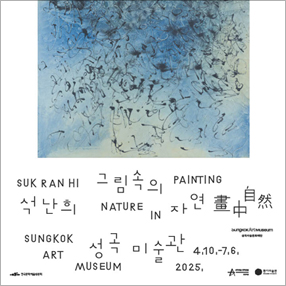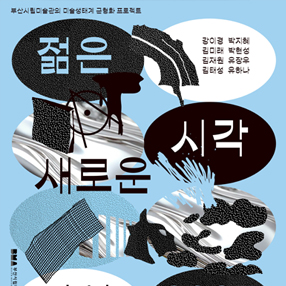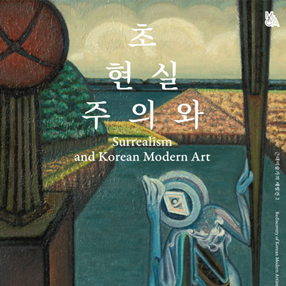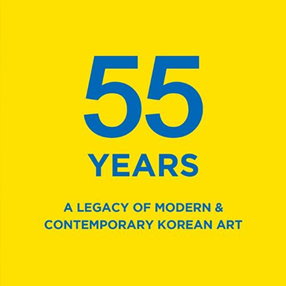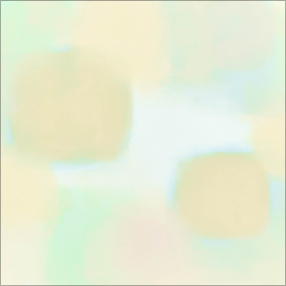본문
-
홍일화
익숙한 초상화 리넨에 유채, 100x81cm, 2013
홍일화
익숙한 초상화 리넨에 유채, 116x73cm, 2014
홍일화
익숙한 초상화 리넨에 유채, 65x100cm, 2014
홍일화
익숙한 초상화 리넨에 유채, 100x81cm, 2013
Press Release
갤러리 담에서는 6월을 맞이하여 프랑스에서 활발하게 작품활동을 하고 있는 홍일화작가의 전시를 기획하였다. 홍일화 작가는 일관되게 여성에 대한 이야기를 그려오고 있는데 작가한테 있어서 여성성은 사회적으로 관습적인 미의식에 대한 문제를 제기한다. 성형수술과 화장으로 중독된 여성의 얼굴들을 통해서 과연 아름다움이 어디에 있는지를 묻고 있다. 화장은 하면 할수록 진하게 된다고 하는데 이를 의식하지 못하고 얼굴에서 흘러내리는 화장품들이 본래의 아름다움에 역겨움을 불러일으키게 된다. 과도한 화장으로 인해 흘러내리는 물감들에도 아랑곳하지 않고 의연하게 있는 여자들의 모습과, 오염물질로 뒤덮여 죽은 바다동물의 시체를 머리에 이고 있는 모습들에서 인간 본연의 모습에 대한 소멸을 암시하고 있다.
홍일화 작가는 경기대학교에서 서양화를 전공한 후 프랑스 ECOLE DES BEAUX-ARTS를 졸업 후 현재 프랑스에서 작업 중이다.
이번 전시에는 2012년부터 2014년 사이에 제작된 시작 15여 점이 출품될 예정이다.
작가의 글
왜 자연적인 이미지가 인위적인 것에 비해 더 긍정적인 반응을 불러오는가? 자연적인 것과 인위적이라는 개념은 아직도 계속 지속 되고 있다. 오랜 시간에 걸친 인류 진화를 거듭 반복해 왔기에 우리는 더 이상 어떤 것이 자연적이고 인위적인 것에 대해 분별할 수 있는 지표를 잃어 버렸는지도 모른다. 그렇지만, 우리는 자연을 인간의 창조물에 대한 반대말로 인식한다. 자연적인 것은 무조건 좋은 것이고 인위적인 것은 안 좋은 것인가? 왜 이렇게 억측하는가? 자연 미가 넘치는 여자가 좋습니까, 아니면 인공미가 넘치는 여자가 좋습니까? 어떻게 옷을 자연스럽게 입습니까? 어떻게 자연스러운 방법으로 화장을 합니까? 자연스러운 성형수술이 존재합니까? 우리는 가끔 인위적이거나 자연적인가요? 오늘날 인간의 창출해낸 ‘L'artiUicialisation‐인공화. 인위화’이란 도박을 통해 인간의 영혼에 관한 많은 것들을 습득하게 된다. 하지만 계속해서 생겨나고 번식하는 신물질들을 통해 단순하게 변해만 가는 우리의 복잡한 정신세계는 더 이상 이런 문제를 언급하지 않을 것이다. 계속 진화해왔고 앞으로도 진화할 것이기 때문이다. 화면 한 가득 선이 여린 인간의 얼굴이 있다. 아름다운 짙은 파란색의 얼굴은 물이 되어 이마에서 눈으로 코로 잎으로 귀로 턱선을 타고 영롱한 물방울이 되어 후두투툭 흘러버린다. 자신의 얼굴이 흘러내리는데도 당황하는 듯한 표정은 없다. 입술을 맛보는 듯한 혀만이 약간의 의지를 보이고 있을 뿐. 눈을 감고 있어 아는 듯 모르는 듯 웃는 것도 찌푸린 것도 아닌 모습은 차라리 담담하다고 해야 하겠다. 이렇듯 모양이나 질감이 사실적으로 묘사된 얼굴과는 대조적으로 어깨로 내려가는 목부분에서 끝난 살색의 목은 양 높낮이를 달리하며 불분명하게 형태가 묘사되어 있지 않아 묘한 분위기를 만들어낸다. 그리고 배경 화면의 밝은 파란색은 이것들과 함께 어우러져 있다. 흘러내리는 이 얼굴은 시선을 잡는다. 그런데 얼굴만 흘러내리는 이유는 무엇일까?
목만이 인간의 살색을 그대로 가지고 있는 이유는 무엇일까? 여자는 얼굴이 아름다워 보이기 위한 방법으로 얼굴 화장과 얼굴 성형을 많이 선택하고 있는데 얼굴이 물이 되어 흘러내리는 것은 작가가 인공적인 얼굴에 대한 진실성에 대하여 질문을 던지고 있지 않나 싶다. 전작들에서 보여진 이미지의 진실성을 뒷배경으로, 가상영상을 만들기 위해 쓰는 크로마키스크린(Chroma‐key screen)이 사용되는 파란색을 차용함으로서 이것을 대변했듯 이번에는 영역을 좀 더 확대하여 얼굴 자체의 진실성에 대한 본질적인 질문을 하고 있는 것이 아닐까 싶다.
Makeup for yourself the Female Skin is No Longer Power We forfeit three quarters of ourselves in order to be like other people. ‐ Arthur Schopenhauer
I am now reading world‐renowned makeup artist Bobbie Brown? Beauty Evolution. Entering the New York makeup‐world in her 20s, she worked with models like Cynthia Crawford.
Although belittled by their beauty, Brown accounts for how the?ost beautiful makeup?makes it unnecessary for comparison with others. Brown realizes that the face of an actress with no furrows and blemishes is the result of a photographer or an art director. The photos are enhanced and modiUied by an effort to cover defects in the face, deleting furrows and swollen or drooping parts under the eye, and contrast dented parts of the face. I discover a warmhearted beauty in the face of Bobbie Brown, who is 154 cm tall and aged 50, with wrinkles around her eyes and lips. No matter how beautiful a way may be, it is of no use, if we lose our destination. Although the fashion changes, one? style is everlasting. Even if one? makeup changes, his appearance should be maintained. The right path of makeup is to make us look a little more beautiful.‐ Bobbie Brown While watching a television advertisement, I find an impressive commercial saying ?or women the skin is power.? model dressed up as an empress showed her white face with no blemishes to men lowering their heads, boasting of her lofty elegance. In the world where skin has become an indicator for success and power, it is reported that, irrespective of gender, many people visit skin clinics to get a job. It is known that more than 70% of women suffer from society? High aesthetic standards? Today, I have chosen paintings for women who are worn out, living in an age of beauty‐ism who Ulood plastic surgeries. Artist Hong Il‐hwa presents paintings that show his pictorial insights into women? Beauty and the questionable conditions of beauty. A number of creatures put on the head of a girl ‐ What does this mean? Look at her skin in Hong Il‐hwa? Painting. These are living things, from which remarkable substances to prevent furrowing and skin aging are produced. As a woman? Obsession with fair skin seems endless; they look for such substances, even in a Uish? bladders, or the placenta. Hong depicts typical beauties through an appropriation of identification and fashion photographs. Hong metaphorically criticizes ideal‐women images, fabricated by the mass media, by appropriating imagery used in fashion magazine Elle. He unveils portraits of the women of our times underlined with somehow perfect skeletons, protruding clavicles, and excessive makeup. In an age of makeup addition, the general zeal for ssangeol ‐ no‐makeup face ‐ is spreading, but even this is employed as a form of marketing. Hong portrays extremely beautiful women, but every woman has a defect in her face. These images reveal the psychology of women who wear makeup. Most women want to have big, round eyes, a sharp, long nose, reddish lips, an even set of teeth, and slick hair. They usually spend a lot of time and money on their beauty. The advertising by cosmetics Uirms using such desire can shatter a woman? mind. Women otherwise themselves, expecting someone to demine their own beauty. Makeup has become a technique of camouflage. Women are harassed by their other. But there is no good reason for them to live like this. One who evaluates my life and face is me, not others. But when I have no criteria in which to estimate my own beauty, I pay attention to the other? Evaluations. Both men and women are captured by such beauty‐criteria like full lips, an elastic neck, protruding clavicle, wrinkle‐free skin. Hong? Paintings denounce the reality of Korea, addicted it seems to artificial beauty and plastic surgery. Cosmetic surgery is a way to live a survival‐of‐the‐Uittest life, in an age of beautiful appearances, and so skin becomes a power symbol. A big problem here is, the typical Western face gets applied to an Eastern face, through modified eyes, nose, lips, even the skin. I sometimes imagine how my face would change if I got a facial Botox injection. Why has our society been captured by the Dongan (young face) syndrome, and the myth of restoring youth through plastic surgery? It is perhaps caused mainly, by our misunderstanding of old age. We often defined old age as equivalent to retirement; being useless; a state deprived of energy and nutrients. Youthfulness is thus considered a privilege, power, and competitive. That youth is so highly credited is of course proper within society; but at the same time we fear old age and the loss of our ability to grow old elegantly. An interesting conclusion here was introduced in a social psychology journal. In answer to the question? Hat is necessary for a happy old age?? came, ? o have matured psychological defense mechanisms,? Including self‐respect, self‐management, and positive treatment of daily emotions. This can be simply referred to perhaps, as a good psychological attitude. I am a man, but envy women wearing makeup. Makeup probably means having the time to examine my face, rather than simply taking care of my appearance. It is to maximize my body? merits, rather than concealing its demerits ‐ perceiving it positively. It is also about seeing my body as an optimal combination that God created. I suggest therefore, believing in loving your face and body is the best was to love yourself. A tender human face Uills a canvas. This good‐looking, dark blue face turns into water drops, Ulowing from the forehead to the eyes, nose, and mouth. The face shows no embarrassment, even if it melts and Flows down. This face appears placid whether it knows it or not. Unlike a realistic face, in terms of form and texture, this face is depicted vaguely, its Flesh‐colored neck emitting a subtle, weird atmosphere. The blue background accords with them. This Flowing face captures our gaze. Why does this face only Ulow down? Why does the neck only have the color of human Ulesh? The woman selects makeup and plastic surgery to make her face look beautiful. The Ulowing face is a metaphor for the artist? Question about the truth of an artificial face. As the artist employed blue to prove the authenticity of images in his previous work, he poses a fundamental question concerning the veracity of artificial faces.전시제목홍일화展
전시기간2014.06.10(화) - 2014.06.24(화)
참여작가 홍일화
관람시간24:00pm~18:00pm 일12am~05pm
휴관일없음
장르회화와 조각
장소갤러리 담 Gallery Dam (서울 종로구 윤보선길 72 )
연락처02-738-2745
Artists in This Show
갤러리 담(Gallery Dam) Shows on Mu:um
Current Shows




